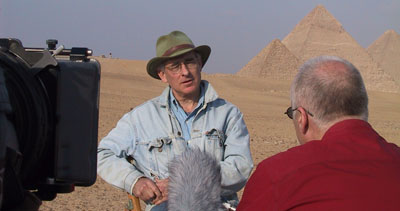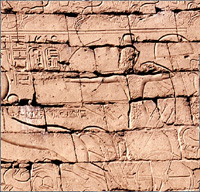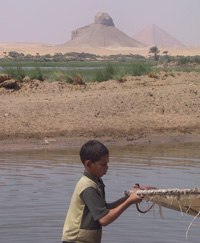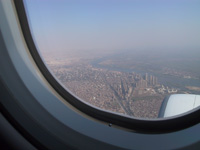“Quite a pile”

I’m back in Egypt with the crew shooting the Eternal Egypt documentary. Everything’s going as expected: the hurry-up-and-wait of the film business multiplied by the hurry-up-and-wait of Egyptian life.
We interviewed Mark Lehner today. Along with Zahi Hawass and in addition to referring to the Great Pyramid as “quite a pile,” he’s most (recently) known for his discovery of the “workers’ village” (photos), the urban complex of the pyramid-builders at Giza. He’s a fascinating guy and, like Kent Weeks, wonderfully articulate about the importance of what he’s doing. You’ll have to wait for the documentary for the full scoop, but something he said today really made me think. He was explaining how astonishing the pyramids of the Fourth Dynasty are, given their precision and size. Importantly, he noted that no undertaking on their scale in the time it took to build them was ever duplicated in ancient Egypt. He then made a quick aside — I’ll bet it’ll end up on the cutting-room floor — that this burst of activity and innovation can be likened to the US space program’s accomplishments in the 1960’s. The implication is that we’ve not achieved anything comparable in the 35 years since we landed on the moon. Which, of course, is true as far as manned spaceflight goes.
But it got me thinking. There are many, many people who believe the only way to explain the Giza pyramids is to turn to supernatural forces, lost civilizations, or alien intervention. “Pyramidology” is an entire pseudo-science dedicated to these claims and there is no shortage of TV programming that laps it up. So I ask, if we are unable to get out of low-Earth orbit in the coming decades will the popular imagination begin to search for extra-human explanations as to how we accomplished the moon landings in the first place? That is, if enough time passes after a watershed technical achievement is it inevitable that humans will seek to explain its occurence in non-human terms? Certainly, there is a fringe that always does, but I wonder if technical singularlites like the Apollo program are doomed to mystification if not repeated. Can’t we just go to Mars and not find out?
Linguistic sidenote. The location producers here in Egypt are known as “fixers” and they are a three-person family team. They are extraordinarily good at what they do. They are also near-anagrams of one another: Romany, Ramy, and Mary. Wish I had thought of that with my kids.
Speaking of battle on the Sinai
Looks like I got out just in time. Apparently two vacation resorts on the Sinai peninsula were just bombed. Yikes.
Kadesh

On the one major road in and out of the Cairo airport you pass a military academy and a giant, seemingly-deserted complex known as the Panorama of the October 1973 War. Cold War-era tanks and planes are mounted like museum pieces, but they come off more like scientific specimens — butterflies carefully pinned down for the curious. On the walls of the complex facing the road are murals depicting the conflict. They are garish and busy. The murals are meant to immortalize the victory of the Egyptian forces over the Israelis which ultimately resulted in the return of the Sinai peninsula to Egypt. The art is sort of like what you’d see on the cover of a war-theme comic book or a role-playing instruction manual. Thing is, historians usually call the conflict a military draw. The Egyptian Third Army was totally surrounded by the time a UN cease-fire was agreed to. OK, big deal.
What gave me a chuckle recently was returning to Luxor Temple. On the massive outermost set of pylons is carved the Battle of Kadesh. This was one hell of a fight, or is so described. Ramesses II from Egypt went at it with Muwatallis the Hittite with approximately 5000 chariots. Like Ramesses himself, visitors to Egypt can’t avoid the Battle of Kadesh. Depictions and descriptions of the battle can be found in no less than eight ancient sites in Egypt. Yet, some scholars wonder if the battle happened at all. And those who acknowledge that there was a battle usually assert that Egypt lost it.
No great insight here. Just found the historical continuity interesting.
Sticker Shock

Not so long ago Egypt suffered horrible terrorist attacks on tourists. One attack, a bomb on a bus full of visitors to the Egyptian Museum, prompted the creation of an entirely new police force known as the Tourist Police. The heightened security has been fairly effective: tourism is at an all-time high (6 million per year) and there is a genuine feeling of safety in the streets of major Egyptian cities. So why, I ask, would Sony plaster cars with bumper stickers that say “This car may be Xploded!” to promote their line of so-hip Xplod! car stereo equipment? The stickers are everywhere. It isn’t unsettling so much as perplexing. Why don’t you give this campaign a try in Iraq, Sony? (And people wonder how this company can do something as stupid as sell an MP3 player than doesn’t play standard MP3 files.) Sheesh!
Beauty Scouting
Apparently, when the mummy of Ramesses II was sent to France for scientific scanning he actually had a passport, just as any corpse crossing country borders must. His profession was listed as “king, deceased.” Not kidding. Reminds me of the customs form the Apollo 11 crew had to fill out when they entered Hawaii after splashing down post-moonshot. What’s the import duty on lunar dirt?
Small world: recently I mentioned reading Reading Lolita in Tehran. Turns out one of the documentary producers I am here with is in talks with the author of that book and some of her students to use it as the seed for a new special on women in Iran. It looks likely to happen. Maybe I should invite her to bookclub.

I spent the day scouting “beauty shots” outside of Cairo. In addition to interviews with Egyptologists and shots of the technology from Eternal Egypt we need establishing shots — and lots of ’em. The pyramids of Giza are impressive, of course, but it is often difficult to frame them well because of the throngs of tourists and how closely modern Cairo crawls to their bases. So, we set out for Dahshur. This area near Saqqara about 40 minutes outside of Cairo is the beta test lab of pyramids. They figured out how to do it right here. The Step Pyramid in the distance is the first of the genre, the jaggy Aztec-like prototype to all that came after. The Bent Pyramid is an odd-looking structure whose angle of slope changes from 52 degrees to 43 degrees about half-way up. It is thought that the original angle was not structurally sound. Clearly they had reason to worry about pyramids falling down.
The Red Pyramid — second largest pyramid in all of Egypt — was the real highlight though. It is what the Great Pyramid must have been like before tourism and Cairene sprawl. It is truly remote, rising straight out of the desert, far from paved roads. The entrance to the pyramid is way up its face so there is considerable climbing required just to get in. The descent into the belly of the pyramid, like most, was harrowing. Poorly lit and tiny, the shaft required a hunched-over trot over slats pounded into a wooden ramp. One feels that panic would easily ignite in a place like this. Too many people, too few exits (namely: one, back the way ye came), and above you several million tons of stone wanting nothing more than to finally cede its struggle with gravity. OSHA-certfied this ain’t. To make things worse there was a small wooden platform at the very bottom of the shaft that, when landed on by visitors happy to finally be upright again, sent out a deep ominous rumble. The shaft acted as an amplifier and by the time the soundwaves reverberated up to us you would have thought the place was about to become a rubble-heap. The first time this happened the producer and I turned tail and scampered back up the shaft where the toothless Egyptian just laughed at us. We gave it another go. Funny thing is, once you are down in the burial chambers you feel quite calm though logically you are in more peril there than in the shaft (further from the exit, etc). The power of “open” spaces, I suppose. Dahshur is also remote enough to still have some stunning vistas at a distance of the pyramid complex. We were able to get some great shots (Quicktime clip) of the monuments from across a small lake. The tranquility of the scene, scored by the call to prayer and birdsong, is absolutely foreign in Cairo proper.
I depart Cairo for Luxor tonight where, no doubt, my computer woes will increase. My hard drive died fitfully an hour before I departed for Egypt so I had to grab a second as I ran out the door. Configuring a new machine on-the-fly is hard enough without spotty Wifi (ok, ok, it is impressive that they even have it now but I should not have to crawl into a corner of my room to use it!) and sluggish dial-up. What’s more, my Egyptian cellphone is constantly pummelled with unsolicited Bluetooth messages from nearby devices. I can block them, but by the time I do my inbox has filled up and pushed out some important information I have saved there. Alas.
To Thebes I go.
Back in Cairo

Having made this trip many times now I’m convinced that the approach pattern for Cairo International Airport is nothing more than “head down the Nile and hang a left at the pyramids.” That is exactly what the Alitalia crew did today. As if they were banking just for the tourists. The normal miasma of baking dust and smog was pleasantly absent; you could see for miles. I happened to be on the correct side of the plane to find the Giza Plateau staring me right in the face as I lifted my window shade. From ground level the pyramids pretty much defy belief, but from the air it is different. Coated in the same sand that stretches west all the way to Libya the pyramids seem to grow right out of the desert, like geometrically-perfect shards of earth thrust out by an ancient quake. ‘Course, Cairo creeps right up to the pyramids’ bases on the east side which provides the necessary scale to eventually invoke the same sense of awe you get when you are staring up at them from the ground.
A curious Egyptian behind me on the plane asked an American next to him out of the blue about the presidential debate a few nights ago. He seemed geniunely curious and, as I have experienced myself on previous trips, his second question was “are you a Republican or a Democrat?” The American responded “I’m an independent.” Maybe he didn’t want to get into the conversation that would necessarily flow from a partisan answer, but it seemed like a cordial conversation. I know an American who says she’s Canadian when she travels abroad. Not because she’s embarrassed so much as because she just doesn’t want to engage in the discussion that almost always comes from that admission. I’d never lie about my nationality, but I do understand the urge to sidestep conversation with a stranger about Bush or Iraq or Osama Bin Laden. I’ve never encountered hostility — not here or in Europe — but there’s genuine curiosity and passion in the questions about our country and, well, sometimes I just can’t muster the energy.
I was on my own tonight, sitting on the patio of the Nile Hilton, drowning in the smoke of direct-burn hookah pipes. Those things are not for the casual shisha smoker. Like lighting ten cigarettes, putting ’em on a bong, and going for it. No thanks. I’ll take the wuss molasses variety. Anyway, I’m reading Reading Lolita in Tehran the story of an all-female book club who discover themselves through censored Western texts in Iran. There’s something painfully meta about me reading this in an Egyptian cafe. Reading Reading Lolita. I should have just brought Nabokov and short-circuited the whole pomo loop.
I’m here this time with a documentary production crew working for the History Channel. They are creating a show on the history of Egyptology and the IBM project (yeah, that one) I launched earlier this year figures prominently in it. I am the technical consultant for the shoot and we’re here securing permissions, slapping the baksheesh, and scouting locations — in that order. The show shoots in November.
OK, I think I’ve fended off jetlag long enough. Time to succumb.













